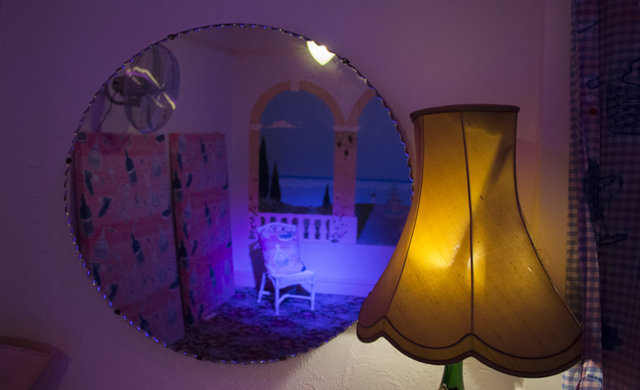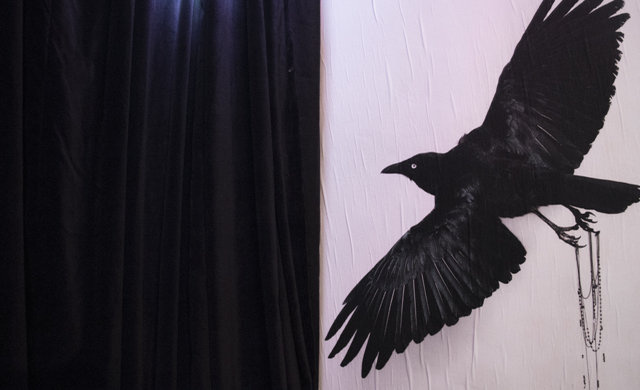Hidden away in the back streets of inner city Richmond, Bakehouse Studios is something of a Melbourne music institution. Run by local legends Helen Marcou and Quincy McLean (founders of the SLAM music activist group), Bakehouse is a sprawling labyrinth of rehearsal rooms that has been a favourite haunt of musicians of varied stripes for over twenty years. Walking around the corridors you’re just as likely to hear skull-crushing death metal, ukulele-driven tropicalia or pristine synth-pop coming from any of the rehearsal rooms.
What makes Bakehouse special is that all of these disparate musicians socialise in the communal kitchen and outdoor area – creating a rare melting pot of ideas and influences in a town whose myriad music scenes so often coexist without meaningful interaction. Bands are formed, friends are made and collaborations are initiated between artists who may never have otherwise crossed paths. Now Bakehouse have extended their cultural tendrils even further, inviting a lineup of stars from the visual art and design world to produce permanent installations in their favourite rehearsal spaces. This means you can now argue with your lead guitarist about turning their bloody amp down whilst surrounded by the work of some of Melbourne’s finest artists. It’s mixed media meets the mixing desk, set design meets the set run, oil paint fumes and drumstick shavings together at last. We spoke with Bakehouse founder Helen Marcou and vegan taxidermist/ sculptor Julia DeVille to find out more about this latest melding of minds.
Videos by VICE
Noisey: How would you describe Bakehouse’s position in the Melbourne cultural community?
Helen Marcou: Bakehouse is a rambling old labyrinth of a place that’s been built from the ground up with reclaimed material and a lot of crazy ideas. We’ve been around for many years and used to feel we were under the radar, a place that only musicians in the know had in common, but after nearly quarter of a century so many musicians have now passed through Bakehouse that we were recently named a ‘Melbourne music landmark’. We get everyone from high school kids having their first ever jam, to International touring artists, so there’s a lot of familiarity and nostalgia about the place. In the early days we hosted seminal acts like MC5, The Saints, Dirty Three, Roland S. Howard, The Go-Betweens, The Avalanches, Eddie Current Suppression Ring, and more recently much loved locals The Drones, Cut Copy and My Disco! have made the studios home. Bakehouse is also the headquarters of SLAM (Save Live Australia’s Music), where we formed the activist group that staged what has been described as the largest cultural rally in Australia’s history. The rally marked a turning point for live music activism and our work continues.
How did the ‘art installations in rehearsal rooms’ concept come about?
Helen Marcou: We’d been approached to use the front wall by the poster guys and decided to alternate the space with large-scale billboards of public art. We thought we’d have an exhibition of the works inside and let some of our visual artist friends loose in some of the grungier rehearsal spaces, but the idea evolved into permanent installations. Bakehouse is a bit of an acquired taste, filled with found objects and ready-mades, so having artists curate immersive environments, especially for musicians, doesn’t seem too weird. Jam rooms are often functional and focus on the technical side of a musician’s craft, we see musicians as three-dimensional and a connection to visual art forms shouldn’t be seen as unconventional.

How did you select the artists involved?
Helen Marcou: All the artists are our mates and haveclose ties to Bakehouse. They are all very different, so each space is unique. We have: Julia DeVille creating a gothic black velvet room; jeweler Cass Partington turning a tiny room that’s loved by grindcore bands into the metal room using 1000 metal discs into sculpture; Stewart Russell filling a room with pulp fiction; the Hotham Street Ladies, guerrilla feminists who work in cake icing have iced an homage to the Rolling Stones recording of Exile On Main Street with a trompe-l’œil of the south of France; a glam rock disaster from Will and Garrett Huxley; a history of the early punk days from Bruce and Peter Milne (complete with the original Tote jukebox!); the river caves of Luna park from Dirty Three guitarist Mick Turner , and a 60’s backstage boudoir from design duo Brustman + Boyd.
How much crossover do you think there is between the Melbourne rock scene and the fine art scene in Melbourne?
Helen Marcou: When at art school young artists and musicians tend to do a bit of everything, but as they get into their practice, they can get stuck in their discipline unless collaborators seek them out. From what we’ve observed, there’s a big connection between experimental music scene and the fine art crowd, the rock scene, and the hip hop scene seek out art in the their own ways.

Julia, what is your relationship with the Bakehouse studios crew?
Julia DeVille: I met Helen and Quincy at the MONA opening in 2011 and we’ve been friends ever since.
How did you approach the jam room as an installation space?
Julia DeVille: I’m creating a very dark Victorian feel for the room. Black velvet curtains, the original pressed metal ceiling and some glass cabinets with taxidermy deer.
Is there a relationship between your art practice and rock/goth music?
Julia DeVille: Nick Cave is one of my biggest inspirations – so I guess the answer is yes!
Miles Brown plays the theremin, writes music and yells about things in Melbourne. Follow him on Twitter: @M1le5Br0wn
More
From VICE
-

-

-

Lauren Levis, who died after taking iboga at the Soul Centro retreat in 2024. (Photo courtesy of the Levis family) -

Photo by Shutterstock
